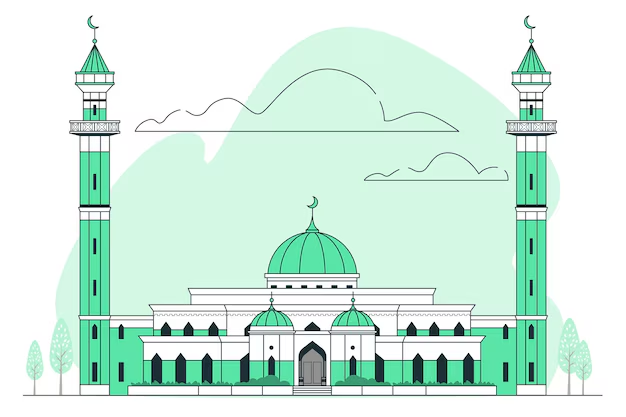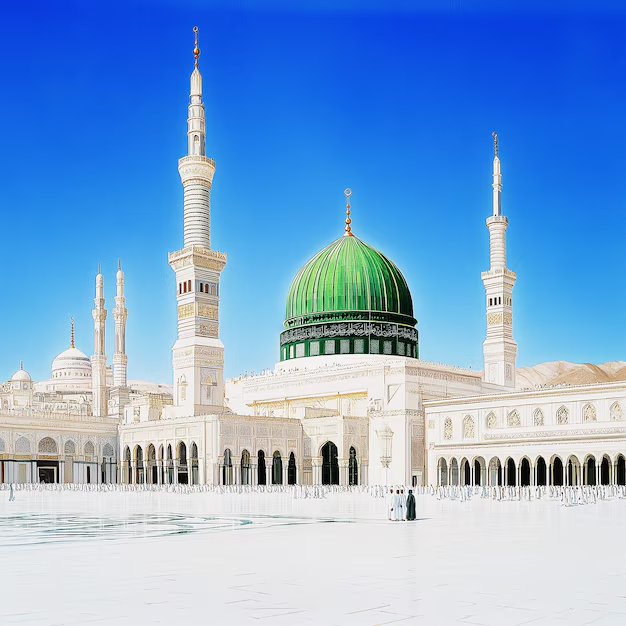History of Masjid al-Nabawi
The Prophet’s Church, or Masjid al-Nabawi, is one of the holy sites in Islam, next only to Makkah’s The Masjid al-Haram. It sits in the hub of Medina, Saudi Arabia, & is highly dear to Muslims all over the world – culturally and religiously. In addition to being the final resting place of Prophet Muhammad (PBUH), it is a haven for millions of those who need sanity and peace.
The Story of the Masjid of al-Nabawi
For Muslims globally, the story of the Prophet’s Mosque, or Masjid al-Nabawi, is of greatest value and is in the core of Islamic history. It has mud walls and a palm-trunk roof. The mosque got bigger and embellished by various Muslim monarchs over time to serve millions of worshippers. . As an archive of Islamic history, Masjid al-Nabawi attracts pilgrims from nearly globe, especially during Ramadan and the Hajj.
The Growth for Design in the Centuries
The mosque has seen multiple expansions and updates, each of which left its unique mark on the structure’s history. It has modern facilities due to the most recent extras, which mix modern comforts with classical beauty.
One of Masjid al-Nabawi’s hallmarks as the green dome.
The Green Dome, which marks the Prophet Muhammad’s (PBUH) last grave location, is one of the mosque’s finest traits. Completed in the 13th century, this iconic building has grown to be a cherished symbol of the mosque and pulls in an array of visitors who wish to pay tribute to the Prophet.
A Spiritual Journey Inside the Mosque
Muslims can offer prayers and ponder their faith in the serene, quiet setting of Masjid al-Nabawi’s interior. Each visitor’s spiritual experience is improved with the big courtyards, finely designed prayer halls, and peaceful air.

The Noble Chamber, or Rawdah
The area inside the mosque between the Prophet’s pulpit and his grave is called the Rawdah, or Garden of Paradise. Supplications are especially sacred in the Rawdah, an area known for its high spiritual significance. Visitors are encouraged to approach with reverence and follow the respectful protocols set for this blessed area.
Other Sacred Places in Masjid al-Nabawi
Along with to serving as the mosque of the Prophet Muhammad (PBUH), Masjid al-Nabawi is respected in Islam for its spiritually significant parts. Set between the Prophet’s residence and his pulpit (minbar), the **Rawdah al-Jannah** (Garden of Paradise) is seen as a garden from Paradise where prayers are especially honored. Despite the usual crowds, many Muslims seek to worship here because of its unique place. Muslims go to to welcome each other as a sign of respect. Key elements of Islamic tradition and devotion are also marked in the mosque’s **Minbar** and many **Mihrabs** (prayer niches), as honor the Prophet’s role as a spiritual teacher and leader.
The proper way to visit Masjid al-Nabawi
Inside the mosque, guest are told to keep their conduct, dress modestly, and avoid from creating loud noises. It is vital to uphold patience, humility, and respect as these are key traits as appear in Islamic teachings.
Prominent People Tied in Masjid al-Nabawi
From the Prophet’s Companions to prominent scholars who shaped Islamic doctrine, the mosque has held some of the most famous people in Islamic history. Each of them had an impact to Masjid al-Nabawi’s past.
Expansion Projects in the Modern Era
Prominent People Tied in Masjid al-Nabawi
From the Prophet’s Companions to prominent scholars who shaped Islamic doctrine, the mosque has held some of the most famous people in Islamic history. Each of them had an impact to Masjid al-Nabawi’s past.
View and It of Masjid al-Nabawi at Night
The mosque’s beautifully lit architecture draws worshippers and visitors who are awed in the structure’s lights.
Masjid al-Nabawi in Relation to the Hajj and Umrah
Masjid al-Nabawi is a major location for pilgrims on the Hajj and Umrah, yet it is not a needed stop. The mosque is a spiritual haven that improves the pilgrimage experience via specific areas and lodgings to help pilgrims in their worship.
How to Get the Most In of A Masjid Nabawi Visit
Visitors are urged to plan their visit at Masjid -Nabawi in a focus on the finest times for prayer and reflection so as for a meaningful experience. One’s spiritual journey can be greatly enhanced by visiting the mosque’s many areas and studying its history.
The Role in Masjid al-Nabawi the Growth in Community and Faith
Masjid Nabawi is an area for religious lectures, social events, and Quranic recitations beside to mass. By uniting Muslims from every era of life together under a single faith, the mosque fosters calm and a sense of unity.

Conclusion
The symbol of Islam’s long history and enduring faith is Masjid al-Nabawi. Every Muslim’s heart and soul contact via the amazing experience of visiting this holy mosque. For more insights on Islamic topics, explore this Islamic resource for guidance on enhancing your faith.
Frequently Asked Questions (FAQs):
- What time of day is best in visit Masjid Nabawi?
- While the mosque is open all year long, many people opt to go during times of peace outside of the Hajj season so as for a more calm experience.
- Is there a clothing need for entering Masjid Nabawi?
- It is compulsory for women to wear a headscarf, and men are asked to act modestly, covering their arms and legs.
- What is the extent in Masjid -Nabawi?
- One of the biggest mosques in the world, Masjid Nabawi can hold over 100,000 people as per recent parts.
- Are non-Muslims able to visit Masjid Nabawi?
- While Medina itself is open to visitors from all walks of life, the mosque usually limited to Muslims.
- Why is the Rawdah so unique?
- One of the holy sites in Masjid Nabawi is the Rawdah, dubbed the Garden of Paradise, where supplications and prayers are highly valued.
Source links
Saudi Embassy in Washington, D.C. – Detailed information about the mosque’s historical evolution and expansions over centuries. Saudi Embassy
IslamWeb – Insights into significant architectural additions and renovations under Caliphs Abu Bakr, Umar, and later leaders. IslamWeb
Archnet – Architecture and layout changes over the centuries, including prayer niches, minbars, and the layout’s evolution. Archnet
Madin Project – Covers the mosque’s historical features such as the Rawdah al-Jannah and the transformation of the mosque over time. Madin Project

